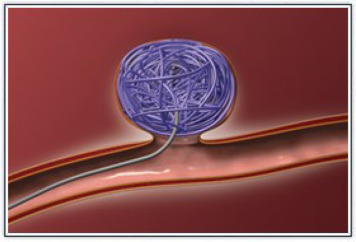Coil Embolization: A Minimally Invasive Vascular Treatment

Contact Us
Related Videos :
Frequently Asked Questions :
1. Is coil embolization a painful procedure?
Coil embolization is generally not painful because local anesthesia and sedation are used during the procedure. Most patients experience mild discomfort or bruising at the insertion site afterward.
2. How long does it take to recover from coil embolization?
Recovery time varies depending on the procedure and patient condition, but most patients can return to normal activities within a few days to a week.
3.Are there risks associated with coil embolization?
While the procedure is generally safe, potential risks include infection, blood clots, and re-bleeding. However, these risks are typically manageable with proper care and follow-up.

Introduction
Coil embolization is a minimally invasive procedure used to treat a variety of vascular conditions. By blocking or redirecting blood flow, it offers significant relief for patients dealing with conditions like aneurysms, arteriovenous malformations (AVMs), and internal bleeding. This article will explore what coil embolization is, how it works, its benefits, and what patients can expect during and after the procedure.
What is Coil Embolization?
Coil embolization is a procedure that involves inserting a small metal coil into a blood vessel to block or reduce blood flow to a specific area. The coil is typically made of platinum, making it soft, flexible, and biocompatible. This allows the coil to conform to the shape of the vessel and effectively seal off the targeted area.
Conditions Treated by Coil Embolization
It is commonly used to treat the following conditions:
- Aneurysms: A bulging or weakened area in the wall of a blood vessel that can potentially rupture.
- Arteriovenous Malformations (AVMs): Abnormal connections between arteries and veins that often lead to bleeding.
- Internal Bleeding: In cases of trauma or medical conditions causing significant bleeding, coil embolization can stop the flow of blood.
- Tumors: Certain types of tumors can be treated with coil embolization by limiting the blood supply, inhibiting growth.
How Does Coil Embolization Work?
Coil embolization is typically performed by an interventional radiologist or vascular surgeon. The procedure is done using a catheter, which is a thin tube inserted into a blood vessel, usually through the groin or wrist.
Step-by-Step Procedure:
- Preparation: Prior to the procedure, a local anesthetic is applied to numb the area. Sedation or general anesthesia may be administered if necessary.
- Catheter Insertion: A small incision is made, and a catheter is inserted into the blood vessel.
- Guiding the Catheter: Using advanced imaging techniques such as X-rays or CT scans, the catheter is guided through the body to the area where the coil is needed.
- Coil Deployment: Once the catheter reaches the targeted area, the coil is deployed. The coil is tightly packed, sealing off the vessel or malformation and stopping the blood flow.
- Completion: After the coil is in place, the catheter is removed, and the incision site is closed.
The procedure usually takes one to two hours, depending on the complexity of the case.
Benefits of Coil Embolization
Coil embolization offers numerous advantages, making it a preferred treatment option for many vascular conditions:
- Minimally Invasive: The procedure requires only small incisions, leading to shorter recovery times compared to traditional surgery.
- Reduced Risk of Complications: Coil embolization eliminates the risks of open surgery, such as infections, significant bleeding, and scarring.
- Precise Targeting: Advanced imaging technology ensures that coils are placed accurately, minimizing harm to surrounding tissues.
- Quick Recovery: Most patients experience a faster recovery, allowing them to return to normal activities sooner.
What to Expect During and After the Procedure
During the Procedure:
- Anesthesia: Local anesthesia numbs the procedure site, while sedation helps keep you comfortable. General anesthesia may be used in some cases.
- Monitoring: Your vital signs will be monitored throughout the procedure to ensure safety.
After the Procedure:
- Recovery Time: Most patients stay in the hospital for a few hours or overnight for observation. The exact duration depends on the complexity of the procedure and the patient’s condition.
- Post-Procedure Care: After the procedure, patients may experience mild discomfort or bruising at the catheter insertion site. Pain medication can help manage discomfort.
- Follow-Up: Follow-up imaging is typically required to ensure that the coil remains in place and the condition is adequately treated.
Patients are usually able to resume normal activities within a few days to a week, depending on the procedure and their overall health.
Risks and Considerations
While coil embolization is generally safe, there are some potential risks:
- Infection: As with any invasive procedure, there is a small risk of infection at the catheter insertion site.
- Blood Clots: Blood clots may form after the procedure, but this can be managed with medication.
- Re-bleeding: In rare cases, the treated vessel may reopen, leading to further bleeding. Additional treatments may be required to address this.
It is important to follow all post-procedure instructions to minimize risks.
When to Seek Professional Help
If you have been diagnosed with a vascular condition such as an aneurysm or AVM, it is essential to seek professional medical advice. Coil embolization is an effective treatment option, but it’s important to discuss all available treatment alternatives with your healthcare provider to determine the best course of action for your condition.
Conclusion
Coil embolization is a highly effective and minimally invasive treatment for a range of vascular conditions. By blocking blood flow to targeted areas, it helps prevent serious complications such as aneurysm rupture and internal bleeding. With its advantages of precision, reduced recovery time, and lower risks compared to traditional surgery, coil embolization is a leading option for many patients seeking relief from vascular issues.
If you or a loved one is considering coil embolization, consult with a medical professional who specializes in vascular treatments to learn more about the procedure and determine if it is right for your condition. To schedule an appointment, visit https://www.drsandeepvaishya.com/.